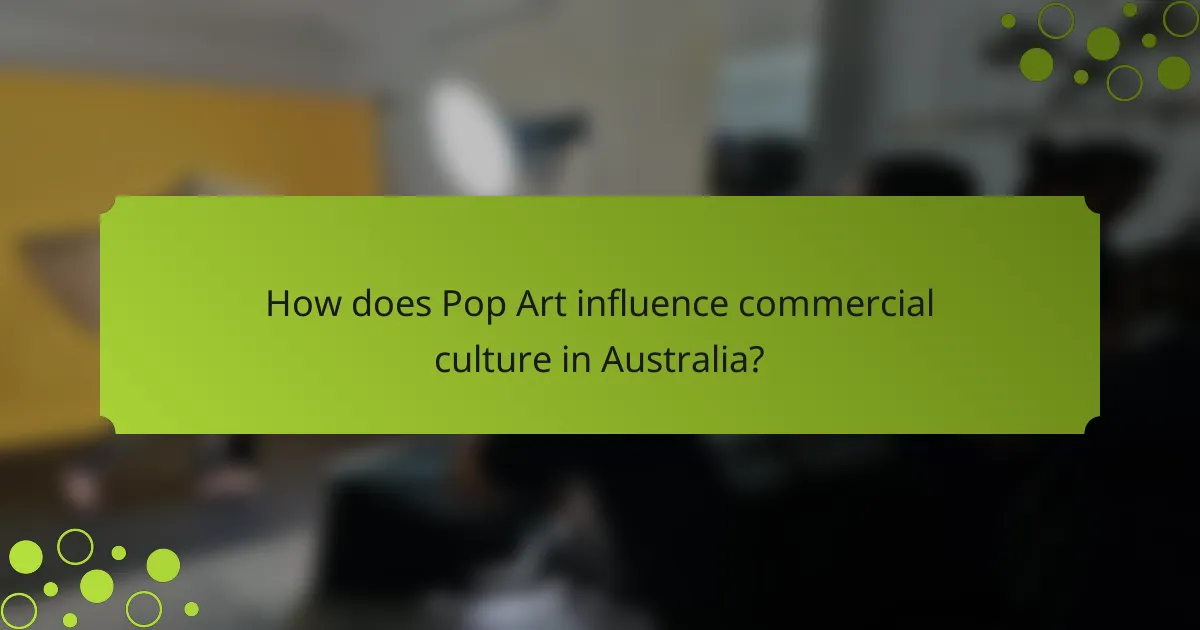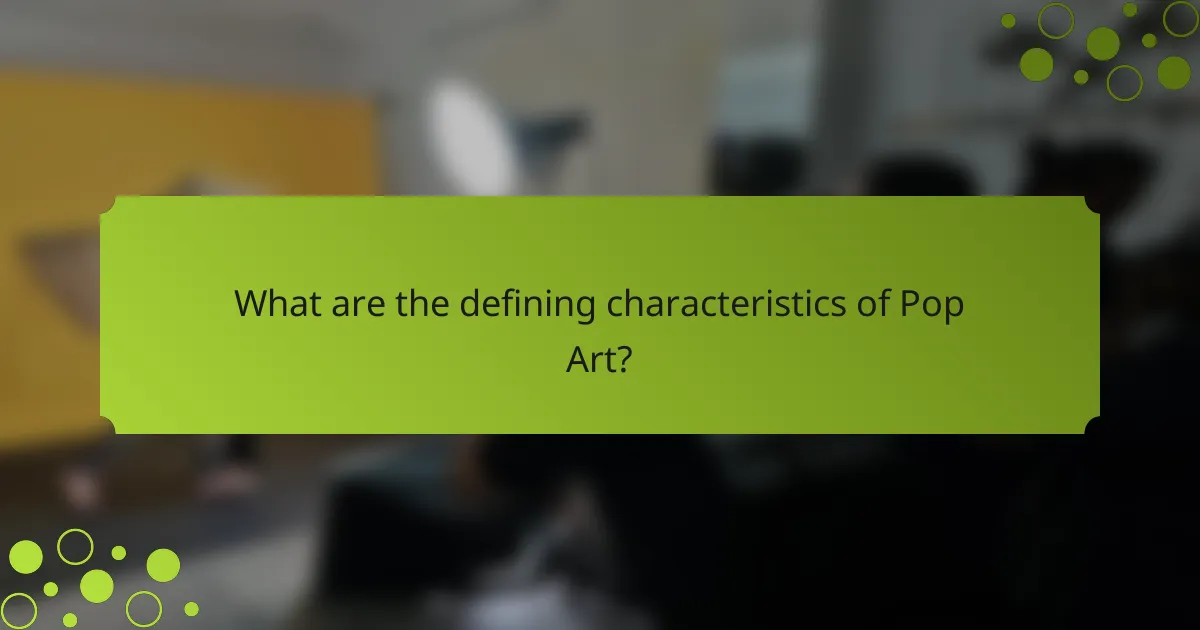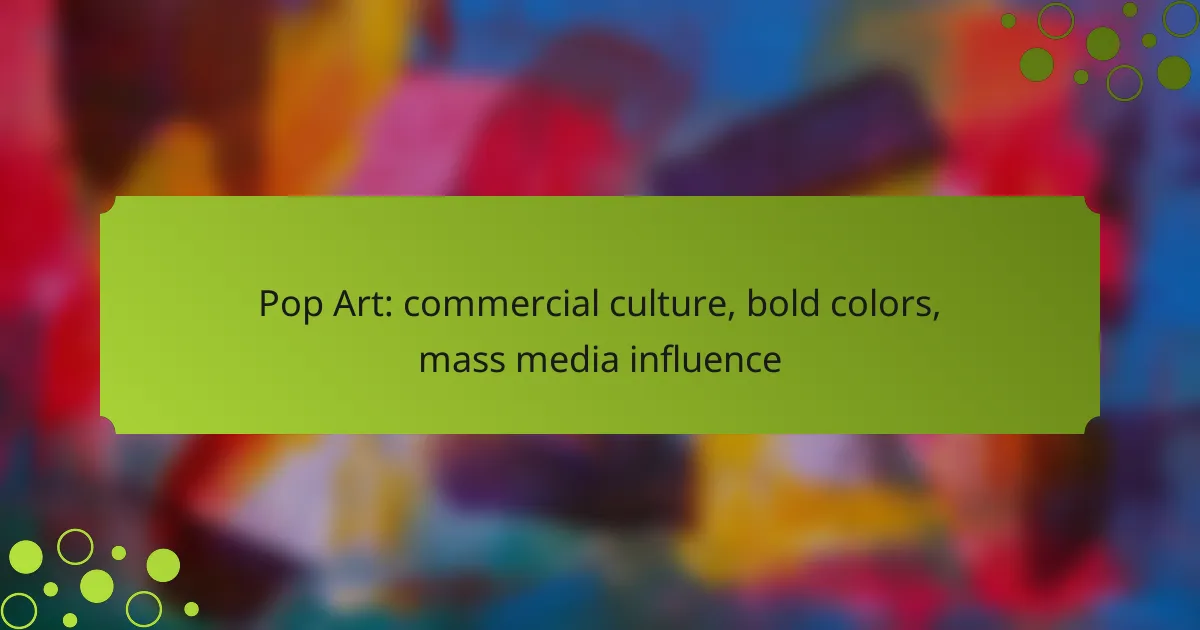Pop Art emerged in the mid-20th century as a dynamic movement that intertwines artistic expression with commercial culture. Characterized by its bold colors and incorporation of mass media imagery, it challenges traditional art boundaries by celebrating everyday products and advertising. This vibrant art form reflects societal trends and consumerism, creating a rich dialogue between art and the influences of popular culture.

How does Pop Art influence commercial culture in Australia?
Pop Art significantly shapes commercial culture in Australia by merging artistic expression with consumerism. This movement utilizes bold colors and mass media imagery to create a visual language that resonates with everyday products and advertising.
Integration of advertising and art
In Australia, Pop Art blurs the lines between advertising and fine art, making commercial products more visually appealing. Artists often incorporate recognizable brand logos and imagery into their work, transforming mundane advertisements into thought-provoking pieces. This integration encourages consumers to engage with brands on a deeper level, viewing them as part of a cultural narrative.
Impact on consumer behavior
The influence of Pop Art on consumer behavior in Australia is profound, as it often encourages impulsive buying through vibrant visuals and relatable themes. Consumers are drawn to products that feature Pop Art aesthetics, which can evoke nostalgia or a sense of belonging. This trend leads to increased brand loyalty, as customers feel a connection to the artistic representation of the products they purchase.
Case studies of Australian Pop Art
Several Australian artists have successfully merged Pop Art with commercial culture, creating notable case studies. For instance, Ken Done’s colorful depictions of Australian landscapes and lifestyle have become iconic, often featured on various merchandise. Additionally, the work of artist Richard Lewer, who incorporates elements of popular culture into his art, has influenced local brands to adopt similar visual strategies, enhancing their market appeal.

What are the defining characteristics of Pop Art?
Pop Art is characterized by its vibrant colors, incorporation of commercial elements, and strong ties to mass media and popular culture. This art movement emerged in the mid-20th century, challenging traditional boundaries by blending fine art with everyday imagery.
Bold colors and graphic imagery
Bold colors are a hallmark of Pop Art, often using bright, saturated hues that capture attention and convey energy. Graphic imagery, including comic-style illustrations and advertisements, is frequently employed to create striking visual compositions.
Artists utilize these elements to evoke emotions and provoke thought, making the artwork accessible and engaging to a broad audience. The use of flat, graphic styles often resembles commercial design, blurring the lines between art and advertising.
Use of mass media and popular culture
Pop Art draws heavily from mass media and popular culture, reflecting the societal changes of its time. Artists incorporate imagery from television, film, and print, creating a dialogue about consumerism and the influence of media on daily life.
This connection to popular culture allows Pop Art to resonate with the public, making it relatable and relevant. By using familiar symbols and icons, artists critique and celebrate the commercialization of society.
Iconic artists like Andy Warhol
Andy Warhol is one of the most iconic figures in Pop Art, known for his innovative techniques and exploration of consumer culture. His works, such as the Campbell’s Soup Cans and Marilyn Diptych, exemplify the movement’s focus on mass production and celebrity.
Other notable artists include Roy Lichtenstein, whose comic strip-inspired paintings highlight the intersection of art and commerce, and Claes Oldenburg, known for his oversized sculptures of everyday objects. These artists collectively shaped the Pop Art movement, leaving a lasting impact on contemporary art.

How does mass media shape Pop Art?
Mass media significantly influences Pop Art by providing a constant stream of imagery and cultural references that artists draw upon. This interaction creates a dialogue between commercial culture and artistic expression, leading to bold, vibrant works that reflect societal trends and consumerism.
Role of television and print media
Television and print media have historically played a crucial role in shaping Pop Art by disseminating popular culture to a wide audience. Artists like Andy Warhol utilized imagery from advertisements and television shows, transforming mundane objects into iconic art pieces that critique consumerism.
Print media, including magazines and newspapers, also contributed by showcasing celebrity culture and fashion trends. This exposure allowed artists to comment on and satirize the values of society, making art accessible and relatable to the public.
Influence of social media platforms
Social media platforms have revolutionized the way Pop Art is created and consumed, enabling artists to reach global audiences instantly. Platforms like Instagram and TikTok allow for rapid sharing of visual content, fostering a new generation of artists who incorporate viral trends into their work.
Moreover, social media encourages interaction and engagement, allowing viewers to participate in the artistic process through comments and shares. This democratization of art can lead to a more diverse range of influences and styles within the Pop Art movement.
Examples of media-inspired artworks
Numerous artworks exemplify the influence of mass media on Pop Art. Warhol’s “Campbell’s Soup Cans” is a prime example, where he elevated a commercial product to high art, challenging the boundaries between consumer goods and artistic expression.
Another notable piece is Roy Lichtenstein’s “Whaam!”, which mimics the style of comic book panels, highlighting the impact of print media on visual storytelling. These works not only celebrate popular culture but also critique its pervasive nature, making them timeless reflections of society.

What are the key Pop Art movements in Australia?
The key Pop Art movements in Australia emerged in the mid-20th century, reflecting the influence of commercial culture and mass media. Australian artists adopted bold colors and popular imagery, creating a unique interpretation of the global Pop Art phenomenon.
Influence of the Melbourne Pop Art scene
The Melbourne Pop Art scene played a pivotal role in shaping the national movement, particularly during the 1960s and 1970s. Artists in this city embraced the vibrant aesthetics of consumerism, often using everyday objects and advertisements as inspiration for their work.
Notable galleries and collectives, such as the National Gallery of Victoria, showcased local artists and facilitated collaborations that enriched the Pop Art dialogue. This environment fostered creativity and experimentation, allowing artists to push boundaries and explore new techniques.
Notable Australian Pop artists
Some of the most influential Australian Pop artists include Richard Larter, who is known for his vibrant, collage-like paintings, and Ken Done, celebrated for his colorful depictions of Australian landscapes and culture. Their works exemplify the bold use of color and commercial imagery characteristic of Pop Art.
Other significant figures include Jenny Watson and Mike Brown, both of whom incorporated personal narratives and social commentary into their art, further expanding the scope of Pop Art in Australia.
Exhibitions and galleries showcasing Pop Art
Exhibitions dedicated to Pop Art in Australia often feature a mix of historical and contemporary works, highlighting the evolution of the movement. Major institutions like the Art Gallery of New South Wales and the National Gallery of Australia regularly host exhibitions that celebrate both local and international Pop artists.
Additionally, smaller galleries and pop-up exhibitions frequently showcase emerging artists, providing a platform for new interpretations of Pop Art. Attending these exhibitions can offer insights into the current trends and themes within the Australian Pop Art scene.

What criteria should be considered when analyzing Pop Art?
When analyzing Pop Art, consider artistic techniques, societal context, and market trends. These criteria help in understanding how Pop Art reflects and critiques commercial culture, utilizes bold colors, and engages with mass media.
Artistic techniques and styles
Pop Art is characterized by its use of bold colors, graphic imagery, and commercial techniques such as screen printing and collage. Artists often draw inspiration from advertising, comic strips, and everyday objects, transforming them into high art. This blending of fine art and commercial aesthetics creates a unique visual language that challenges traditional boundaries.
Common techniques include the use of repetition, as seen in works by Andy Warhol, and the incorporation of mixed media, which adds texture and depth. Understanding these styles is crucial for analyzing how Pop Art communicates its messages.
Societal and cultural context
Pop Art emerged in the mid-20th century, reflecting the rise of consumerism and mass media in Western societies. It critiques the commodification of culture and often blurs the lines between high and low art, making it accessible to a broader audience. This movement was a response to the post-war economic boom, where consumer goods became symbols of status and identity.
Artists like Roy Lichtenstein and Claes Oldenburg used humor and irony to comment on societal norms and values. Analyzing the cultural context helps in understanding the deeper implications of their work and its relevance to contemporary issues.
Market trends and valuation
The market for Pop Art has seen significant fluctuations, influenced by trends in the art world and broader economic conditions. High-profile auctions often feature works by iconic artists, with prices ranging from thousands to millions of dollars. Factors such as provenance, condition, and market demand play crucial roles in determining the value of Pop Art pieces.
Collectors should be aware of emerging artists within the Pop Art genre, as they may represent investment opportunities. Keeping an eye on auction results and gallery exhibitions can provide insights into market trends and potential valuation shifts.

How is Pop Art evolving in the digital age?
Pop Art is evolving in the digital age by integrating technology and social media to reach broader audiences and create interactive experiences. Artists now leverage digital tools to produce vibrant, engaging works that reflect contemporary culture and consumerism.
Emergence of digital Pop Art
Digital Pop Art has emerged as artists utilize software and online platforms to create and share their work. This evolution allows for the incorporation of animation, video, and interactive elements, making art more accessible and engaging for viewers.
Many artists are now exploring digital mediums such as graphic design, 3D modeling, and augmented reality. These tools enable them to produce bold, colorful pieces that resonate with the fast-paced nature of mass media today.
Examples of digital Pop Art include GIFs, memes, and digital installations that often comment on commercial culture. These forms are not only visually striking but also encourage audience participation and sharing across social media platforms.
